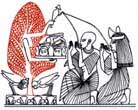
CRITERIA OF SYSTEMS THINKING
In
science, the framework of systems theory—especially as eloped over the past
two decades—seems to be the ideal framework to express the emerging ecological
paradigm. This article addresses the question: what is systems thinking—and
more generally, holistic or ecological thinking—in modern science? The author
identifies three key aspects of systems thinking that are characteristic in all
the sciences. In presenting these aspects, the transition from the old to the
new paradigm for each aspect is emphasized.
Keywords: philosophy of science; systems theory;
paradigm shift
The
first aspect of systems thinking concerns the relationship between the part and
the whole. In the mechanistic, classical scientific paradigm it was believed
that in any complex system the dynamics of the whole could he understood front
the properties of the parts. Once you knew the parts, i.e., their fundamental
properties and the mechanisms through which they interacted, you could derive,
at least in principle, the dynamics of the whole. Therefore, the rule was: in
order to understand any complex system, you break it up into its pieces. The
pieces cannot be explained any further, except by splitting them into smaller
pieces, but as far as you want to go in this procedure, you will at sonic stage
end up with fundamental building blocks—elements, substances, particles,
etc— with properties that you can no longer explain From these fundamental
building blocks with their fundamental laws of interaction you would then build
up the larger whole and try to explain its dynamics in terms of the properties
of its parts. This started with Democritus in ancient Greece and was the
procedure formalized by Descartes and Newton, and has been the accepted
scientific view until the 20th century.
In
the new paradigm, the relationship between the part arid the whole is just the
opposite. We believe that the properties of the parts can only be understood
through the dynamics of the whole, The whole is primary, and once you understand
the dynamics of the whole, you can then derive, at least in principle, the
properties and interactions of the parts. This reversal of the relationship
between the part and the whole occurred in science first in physics during the
first three decades of the century, when quantum theory was developed. In those
years, physicists found to their great amazement that they could no longer use
the notion of a part—such as an atom, or a particle—in the classical sense.
Parts could no longer be well defined. They would show different properties,
depending on the experimental context, appearing, for example, sometimes as
particles and at other times, as waves.
Gradually,
physicists began to realize that nature, at the atomic level, does not appear as
a mechanical universe composed of fundamental building blocks but rather as a
network of relations, and that, ultimately, there are no parts at all in this
interconnected web. Whatever we call a part is merely a pattern that has some
stability and therefore captures our attention. Werner Heisenberg, one of the
founders of quantum theory, was so impressed by the new relationship between the
part and the whole that he used it as the title for his autobiography Der Teil
und das Ganze.
From
structure to process
The
second characteristic aspect of systems thinking concerns a shift from
thinking in terms of structure to thinking in terms of process. Systems thinking
is process thinking. In the old paradigm, it was thought that there were fundamental
structures, and then there were forces and mechanisms through which these
interacted, which gave rise to processes. In the new paradigm, we think that
process is primary, that every structure we observe is a manifestation of an
underlying process. The shift from thinking in terms of structure to thinking in
terms of process is especially important when dealing with living systems.
Accordingly, Ilya Prigogine, one of the leading contributors to the theory of
selforganizing systems (‘dissipative structures’), entitled his basic
textbook From Being to Becoming.
The
third aspect is maybe the most profound of all three and the most difficult to
get used to for scientists. It concerns the metaphor of knowledge as a building,
which has been used in science and philosophy for thousands of years. Scientists
speak about fundamental laws, referring to the fundament, i.e. the basis of
the building of knowledge. Knowledge has to be built of sound and firm foundations;
there are basic building blocks of
matter; there are fundamental laws,
fundamental equations, fundamental constants,
fundamental principles. All this
refers to the building of knowledge, for which we also use the German expression
‘Gedankengebäude’
(building of ideas). So, the metaphor of knowledge as a building with solid
foundations has been used throughout Western science and philosophy for
thousands of years.
In
science, the foundations of knowledge were shattered, or at least were shifting,
several times, and scientists often commented on that fact. Whenever major
scientific revolutions were occurring it was felt that the foundations of
science were moving. Thus Descartes wrote in his celebrated Discourse
on Method
about the sciences of his time: “I considered that nothing solid could
he built on such shifting foundations”. Descartes then set out to build a new
science on firm foundations, but 300 years later, Einstein, in his
autobiography, wrote the following comment on the development of quantum theory:
It
was as if the ground had been pulled out from under one, with no firm foundation
to be seen anywhere, upon which one could have built.
So
again and again, throughout the history of science, there was a feeling that the
foundations of knowledge were shifting, or even that they were crumbling. In the
present time, the paradigm shift which is happening now, again evokes such a
feeling, but this time it may be the last time; not because there won’t be any
more progress or any more changes, but because there won’t be any foundations
in the future. We may not see it necessary in a future science to build our
knowledge on firm foundations, and we may replace the metaphor of the building
by the metaphor of the network. Just as we see reality around us as a network of
relationships, our descriptions, too—our concepts, models, and theories—will
form an interconnected network representing the observed phenomena. In such a
network, there won’t be anything primary and secondary, and there will not be
any foundations.
This
metaphor of knowledge as a network with no firm foundation is something that
is extremely uncomfortable for scientists. In physics it was stated explicitly
for the first time 25 years ago in the so-called bootstrap theory of particles,
formulated by Geoffrey Chew. According to the bootstrap theory, nature cannot be
reduced to any fundamental entities, like fundamental building blocks of matter,
but has to be understood entirely through self-consistency. Things exist by
virtue of their mutually consistent relationships, and all of physics has to
follow uniquely from the requirement that its components be consistent with one
another and with themselves.
Over
the past 25 years, Chew has been using the bootstrap approach, together with his
collaborators, to develop a comprehensive theory of subatomic particles,
together with a more general philosophy of nature. This bootstrap philosophy not
only abandons the idea of fundamental building blocks of matter, but accepts no
fundamental entities whatsoever—no fundamental constants, laws, or equations.
The material universe is seen as a dynamic web of interrelated events. None of
the properties of any part of this web is fundamental; they all follow from
the properties of the other parts, and the overall consistency of their
interrelations determines the structure of the entire web.
The
fact that the bootstrap philosophy does not accept any fundamental entities
makes it, in my opinion, one of the most profound systems of Western thought. At
the same time, it is so foreign to our traditional scientific ways of thinking
that it is pursued only by a small minority of physicists.
Role
of approximation
The
three aspects of systems thinking in science which I have presented are all
interdependent. Nature is seen as an interconnected, dynamic network of
relationships, in which any ‘parts’ are merely relatively stable patterns,
and natural phenomena are described in terms of a corresponding network of
concepts, in which no part is more fundamental than any other part.
This
new approach to science immediately raises an important question. If everything
is connected to everything else, how can you ever hope to understand anything?
Since all natural phenomena are ultimately interconnected, in order to explain
any one of them we need to understand all the others which is obviously
impossible. What makes it possible to turn the web philosophy, or network
thinking, into a scientific theory is the fact that there is such a thing as
approximate knowledge. This insight is crucial to all of modern science. If one
is satisfied with an approximate understanding of nature, one can describe
selected groups of phenomena in this way, neglecting other phenomena which are
less relevant. Thus one can explain many phenomena in terms of a few, and
consequently understand different aspects of nature in an approximate way
without having to understand everything at once.
Scientific
theories, then, are approximate descriptions of natural phenomena. They can
never provide any complete and definitive understanding. To put it bluntly,
scientists do not deal with truth; they deal with limited and approximate
descriptions of reality.
| |
|

|
Front Page
|
|
Spiritual Traditions
|
Mythology
|
Perennial Ethics
|
Spotlights
|
Epistemology
|
Alternative Medicine
|
Deep Ecology
|
Depth Psychology
|
Nonviolence &
Resistance
|
Literature
|
Books & Readings
|
Art
|
On the Lookout
|

|
|